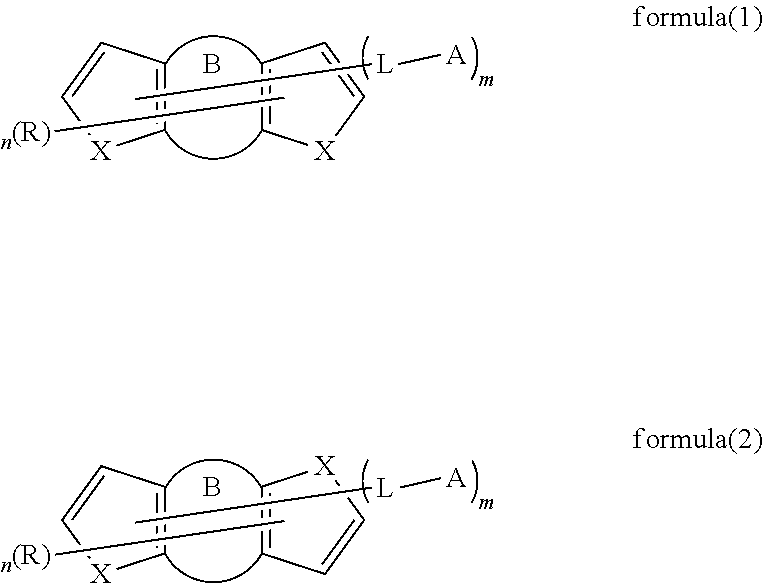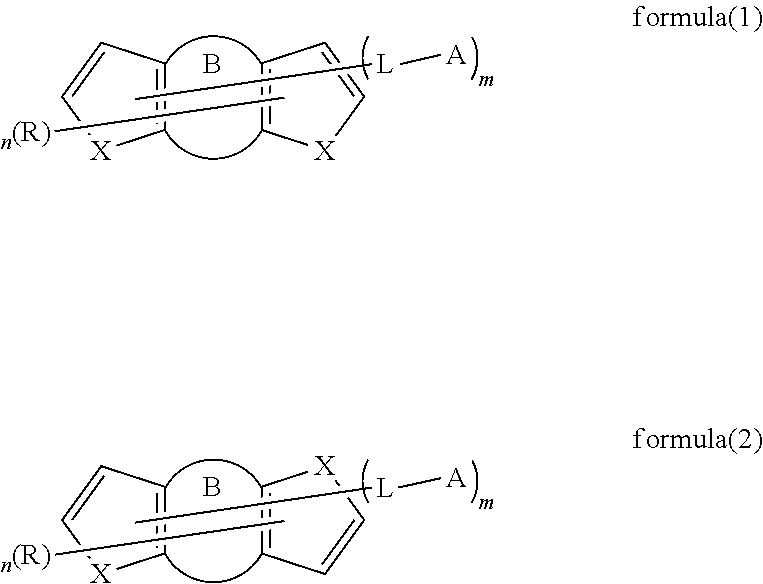Organic compound for organic EL device and using the same
a technology of organic el and compound, which is applied in the field of organic compound and organic el device using the same, can solve the problems of unsatisfactory efficiency and driving voltage of industrial practice use, unsatisfactory half-lifetime of the material used for the phosphorescent host for emitting layer, and only 25% internal quantum efficiency of the fluorescence electroluminescent device, etc., to achieve excellent thermal stability, long half-life time, and high luminance efficiency
- Summary
- Abstract
- Description
- Claims
- Application Information
AI Technical Summary
Benefits of technology
Problems solved by technology
Method used
Image
Examples
example 1
Synthesis of C4
Synthesis of 1,5-dichloro-2,6-dihydroxynaphthalene
[0024]
[0025]A mixture of 15 g (93 mmol) of 2,6-dihydroxynaphthalene, was dissolved in acetic acid (300 ml) under nitrogen, and then cool to 10° C., 15 ml (187 mmol) Sulfuryl chloride was then added, and the mixture was stirred 16 hr. After completion of the reaction, 400 ml of water was added, while stirring and the precipitated product was filtered off with suction. To give 18.2 g (yield 85%) as a white solid.
Synthesis of 1,5-dichloronaphthalene-2,6-diylbis(trifluoromethane sulfonate)
[0026]
[0027]A mixture of 18.2 g (79 mmol) of 1,5-dichloro-2,6-dihydroxynaphthalene, 38.5 ml (480 mmol) of pyridine, and 300 ml dichloromethane was placed under nitrogen, 33.5 ml (199 mmol) Trifluoromethanesulfonic anhydride was then added, and the mixture was stirred two hour, water 50 ml and 1M HCl 50 ml were added to the mixture and the organic layer was separated and washed with dichloromethane. After drying over magnesium sulfate, the...
example 2
Synthesis of C5
Synthesis of 2-Bromonaphtho[1,2-b: 5,6-b′]dithiophene
[0036]
[0037]A mixture of 4.8 g (20 mmol) of Naphtho[1,2-b:5,6-b′]dithiophene, 300 ml of Dry THF, was placed under nitrogen, and then cool to −70° C., 12.8 ml (32 mmol) n-BuLi (2.5M in hexane) was then added, and the mixture was stirred 1 hr, 14.3 g (44 mmol) was then added, and the mixture was stirred 18 hr at 25° C., After finishing the reaction, the mixture was extracted with 500 ml dichloromethane and 200 ml water, the organic layer was dried with anhydrous magnesium sulfate, the solvent was removed and the residue was purified by column chromatography on silica(hexane) to give product 5 g (yield 78%) as an off-white solid.
Synthesis of C5
[0038]
[0039]A mixture of 3.2 g (10 mmol) of 2-Bromonaphtho[1,2-b:5,6-b′]dithiophene, 4.8 g (11 mmol) of 2,4-diphenyl-6-(3-(4,4,5,5-tetramethyl-1,3,2-dioxaborolan-2-yl)phenyl)-1,3,5-triazine, 0.23 g (0.2 mmol) of tetrakis(triphenyl phosphine)palladium, 20 ml of 2M Na2CO3, 40 ml of...
example 3
Synthesis of C9
Synthesis of 2-(4,4,5,5-tetramethyl-1,3,2-dioxaborolan-2-yl) naphtha[1,2-b:5,6-b′]dithiophene
[0040]
[0041]A mixture of 6.4 g (20 mmol) of 2-Bromonaphtho[1,2-b:5,6-b′]dithiophene, 6.0 g (24 mmol) of bis(pinacolato)diboron, 0.46 g (0.4 mmol) of tetrakis(triphenylphosphine)palladium, 5.8 g (60 mmol) of potassium acetate, and 200 ml 1,4-dioxane was degassed and placed under nitrogen, and then heated at 90° C. for 16 h. After finishing the reaction, the mixture was allowed to cool to room temperature. The organic phase separated and washed with ethyl acetate and water. After drying over magnesium sulfate, the solvent was removed in vacuo. The residue was purified by column chromatography on silica (hexane-dichloro methane) to give product 4.2 g (58%) as a light-yellow solid.
Synthesis of C9
[0042]
[0043]A mixture of 3.7 g (10 mmol) of 2-(4,4,5,5-tetramethyl-1,3,2-dioxaborolan-2-yl)-naphtho[1,2-b:5,6-b]dithiophene, 5.4 g (20 mmol) of 2-chloro-4,6-diphenyl-1,3,5-triazine, 0.22 g...
PUM
| Property | Measurement | Unit |
|---|---|---|
| triplet energy | aaaaa | aaaaa |
| internal quantum efficiency | aaaaa | aaaaa |
| internal quantum efficiency | aaaaa | aaaaa |
Abstract
Description
Claims
Application Information
 Login to View More
Login to View More - R&D
- Intellectual Property
- Life Sciences
- Materials
- Tech Scout
- Unparalleled Data Quality
- Higher Quality Content
- 60% Fewer Hallucinations
Browse by: Latest US Patents, China's latest patents, Technical Efficacy Thesaurus, Application Domain, Technology Topic, Popular Technical Reports.
© 2025 PatSnap. All rights reserved.Legal|Privacy policy|Modern Slavery Act Transparency Statement|Sitemap|About US| Contact US: help@patsnap.com



